Business Development Case Study: H&M's CSR and Sustainability Efforts
VerifiedAdded on 2023/01/12
|8
|2681
|35
Case Study
AI Summary
This case study examines H&M's corporate social responsibility (CSR) initiatives, focusing on their environmental and sustainability goals within the fast-fashion industry. It identifies challenges such as the high carbon footprint of garment manufacturing, the use of hazardous chemicals, and the need for sustainable resource management. The study analyzes H&M's policies for protecting human rights, including supply chain audits and collaborations with international organizations. It also highlights H&M's philanthropic activities, such as supporting education and providing aid to communities. The report concludes by summarizing the issues faced by the clothing industry in practicing CSR and the importance of continuous improvement in achieving sustainability goals. The report covers the impact of CSR policies, initiatives for environment protection, challenges faced by H&M, policies for human rights, and philanthropic activities for the societies and local communities.
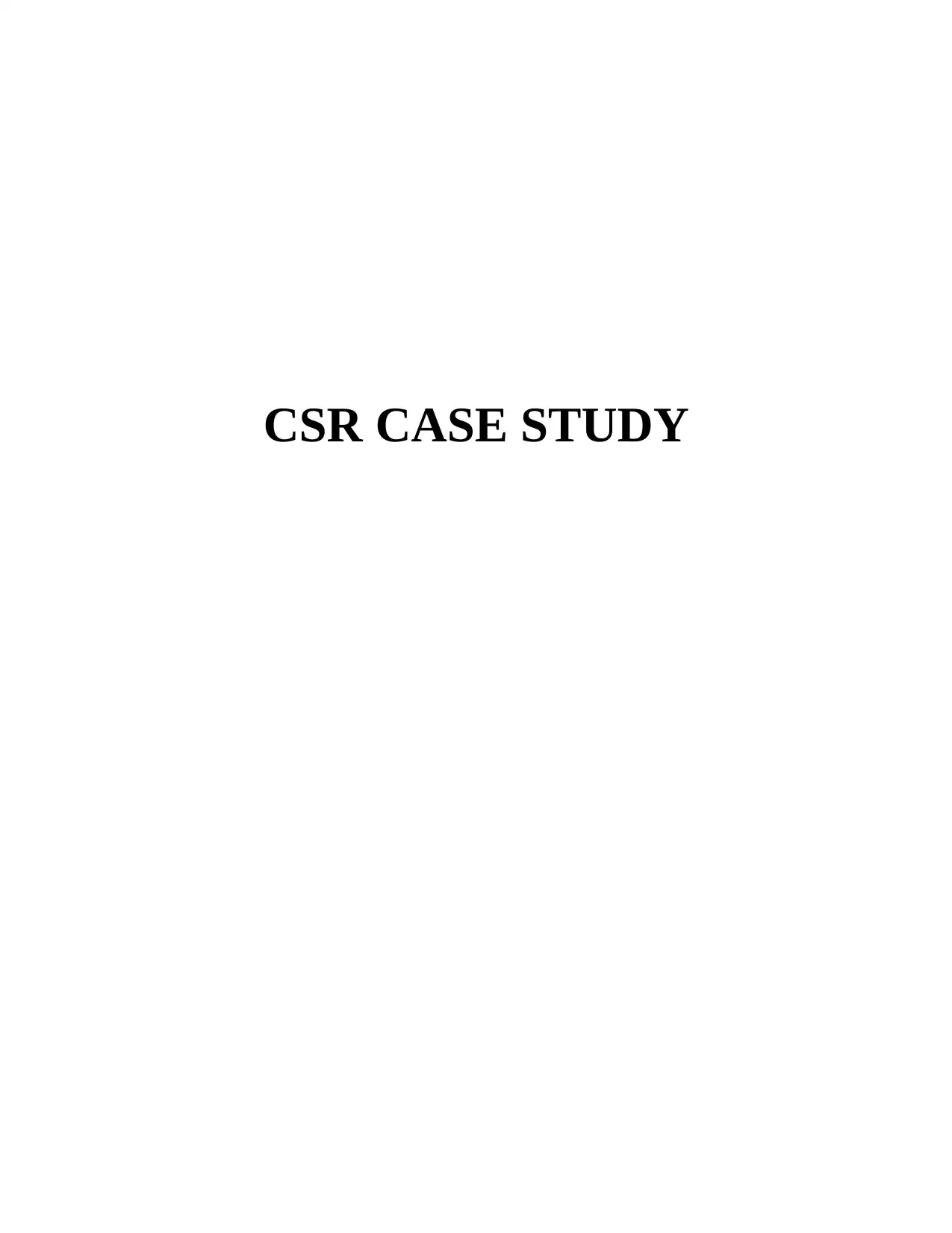
CSR CASE STUDY
Paraphrase This Document
Need a fresh take? Get an instant paraphrase of this document with our AI Paraphraser
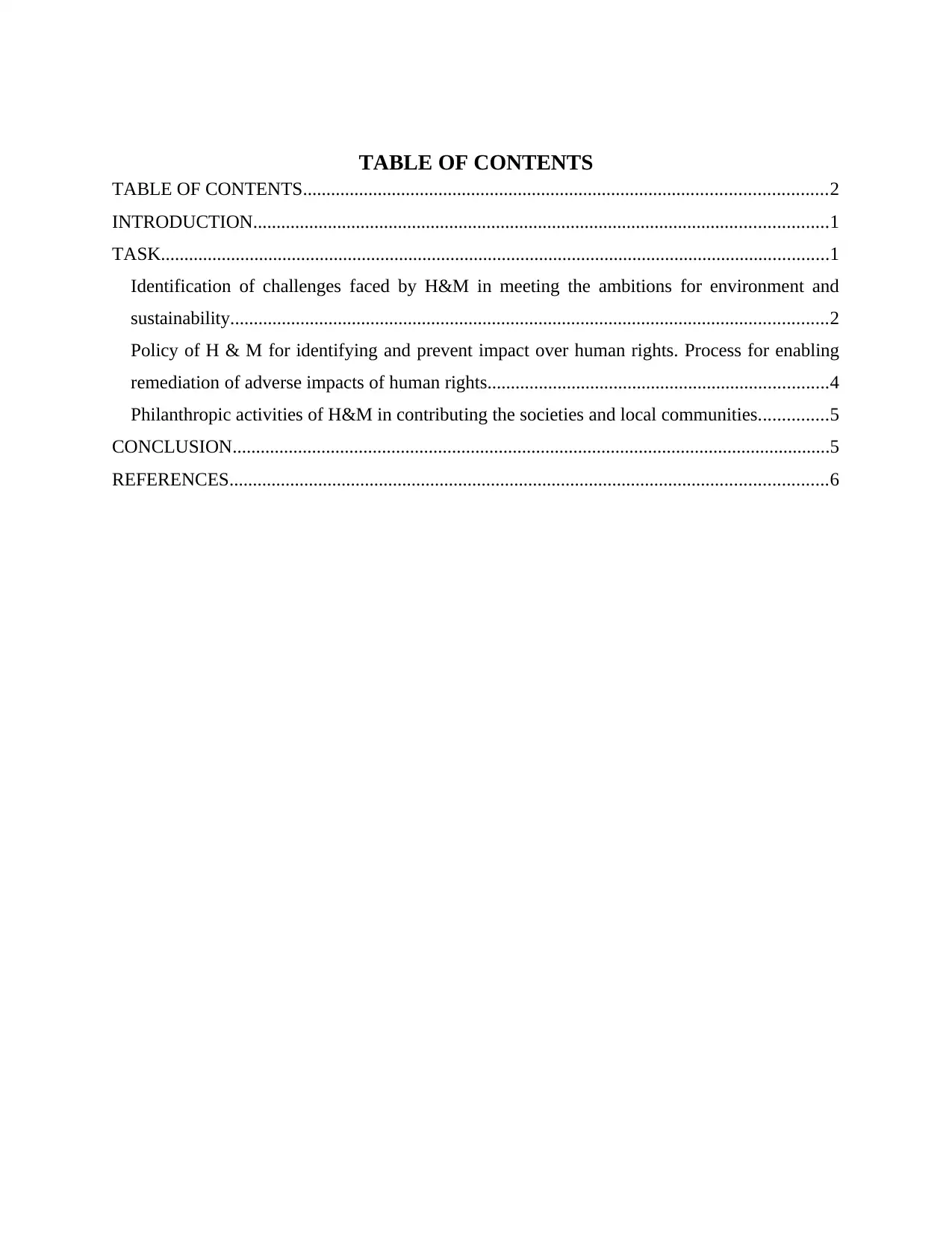
TABLE OF CONTENTS
TABLE OF CONTENTS................................................................................................................2
INTRODUCTION...........................................................................................................................1
TASK...............................................................................................................................................1
Identification of challenges faced by H&M in meeting the ambitions for environment and
sustainability................................................................................................................................2
Policy of H & M for identifying and prevent impact over human rights. Process for enabling
remediation of adverse impacts of human rights.........................................................................4
Philanthropic activities of H&M in contributing the societies and local communities...............5
CONCLUSION................................................................................................................................5
REFERENCES................................................................................................................................6
TABLE OF CONTENTS................................................................................................................2
INTRODUCTION...........................................................................................................................1
TASK...............................................................................................................................................1
Identification of challenges faced by H&M in meeting the ambitions for environment and
sustainability................................................................................................................................2
Policy of H & M for identifying and prevent impact over human rights. Process for enabling
remediation of adverse impacts of human rights.........................................................................4
Philanthropic activities of H&M in contributing the societies and local communities...............5
CONCLUSION................................................................................................................................5
REFERENCES................................................................................................................................6
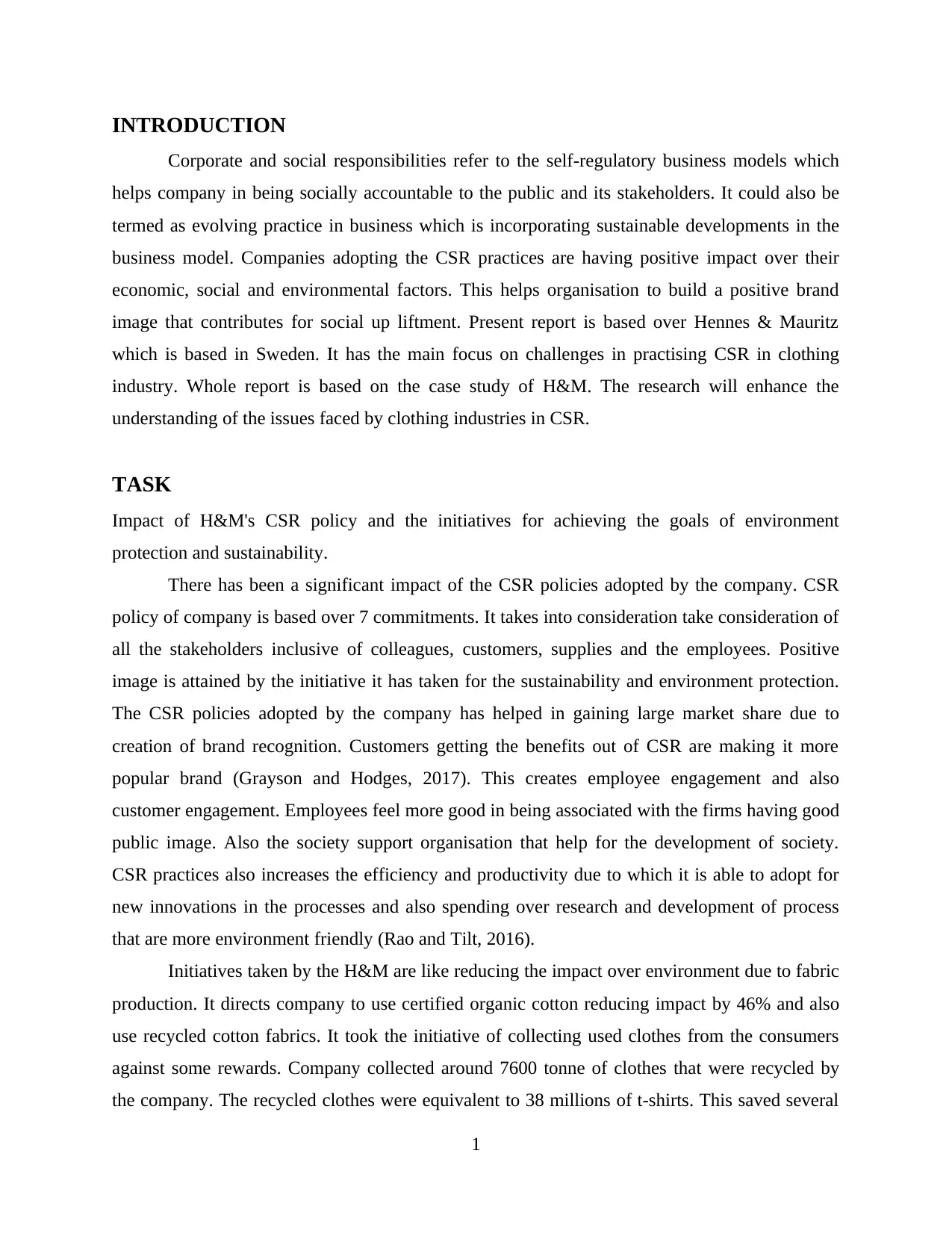
INTRODUCTION
Corporate and social responsibilities refer to the self-regulatory business models which
helps company in being socially accountable to the public and its stakeholders. It could also be
termed as evolving practice in business which is incorporating sustainable developments in the
business model. Companies adopting the CSR practices are having positive impact over their
economic, social and environmental factors. This helps organisation to build a positive brand
image that contributes for social up liftment. Present report is based over Hennes & Mauritz
which is based in Sweden. It has the main focus on challenges in practising CSR in clothing
industry. Whole report is based on the case study of H&M. The research will enhance the
understanding of the issues faced by clothing industries in CSR.
TASK
Impact of H&M's CSR policy and the initiatives for achieving the goals of environment
protection and sustainability.
There has been a significant impact of the CSR policies adopted by the company. CSR
policy of company is based over 7 commitments. It takes into consideration take consideration of
all the stakeholders inclusive of colleagues, customers, supplies and the employees. Positive
image is attained by the initiative it has taken for the sustainability and environment protection.
The CSR policies adopted by the company has helped in gaining large market share due to
creation of brand recognition. Customers getting the benefits out of CSR are making it more
popular brand (Grayson and Hodges, 2017). This creates employee engagement and also
customer engagement. Employees feel more good in being associated with the firms having good
public image. Also the society support organisation that help for the development of society.
CSR practices also increases the efficiency and productivity due to which it is able to adopt for
new innovations in the processes and also spending over research and development of process
that are more environment friendly (Rao and Tilt, 2016).
Initiatives taken by the H&M are like reducing the impact over environment due to fabric
production. It directs company to use certified organic cotton reducing impact by 46% and also
use recycled cotton fabrics. It took the initiative of collecting used clothes from the consumers
against some rewards. Company collected around 7600 tonne of clothes that were recycled by
the company. The recycled clothes were equivalent to 38 millions of t-shirts. This saved several
1
Corporate and social responsibilities refer to the self-regulatory business models which
helps company in being socially accountable to the public and its stakeholders. It could also be
termed as evolving practice in business which is incorporating sustainable developments in the
business model. Companies adopting the CSR practices are having positive impact over their
economic, social and environmental factors. This helps organisation to build a positive brand
image that contributes for social up liftment. Present report is based over Hennes & Mauritz
which is based in Sweden. It has the main focus on challenges in practising CSR in clothing
industry. Whole report is based on the case study of H&M. The research will enhance the
understanding of the issues faced by clothing industries in CSR.
TASK
Impact of H&M's CSR policy and the initiatives for achieving the goals of environment
protection and sustainability.
There has been a significant impact of the CSR policies adopted by the company. CSR
policy of company is based over 7 commitments. It takes into consideration take consideration of
all the stakeholders inclusive of colleagues, customers, supplies and the employees. Positive
image is attained by the initiative it has taken for the sustainability and environment protection.
The CSR policies adopted by the company has helped in gaining large market share due to
creation of brand recognition. Customers getting the benefits out of CSR are making it more
popular brand (Grayson and Hodges, 2017). This creates employee engagement and also
customer engagement. Employees feel more good in being associated with the firms having good
public image. Also the society support organisation that help for the development of society.
CSR practices also increases the efficiency and productivity due to which it is able to adopt for
new innovations in the processes and also spending over research and development of process
that are more environment friendly (Rao and Tilt, 2016).
Initiatives taken by the H&M are like reducing the impact over environment due to fabric
production. It directs company to use certified organic cotton reducing impact by 46% and also
use recycled cotton fabrics. It took the initiative of collecting used clothes from the consumers
against some rewards. Company collected around 7600 tonne of clothes that were recycled by
the company. The recycled clothes were equivalent to 38 millions of t-shirts. This saved several
1
⊘ This is a preview!⊘
Do you want full access?
Subscribe today to unlock all pages.

Trusted by 1+ million students worldwide
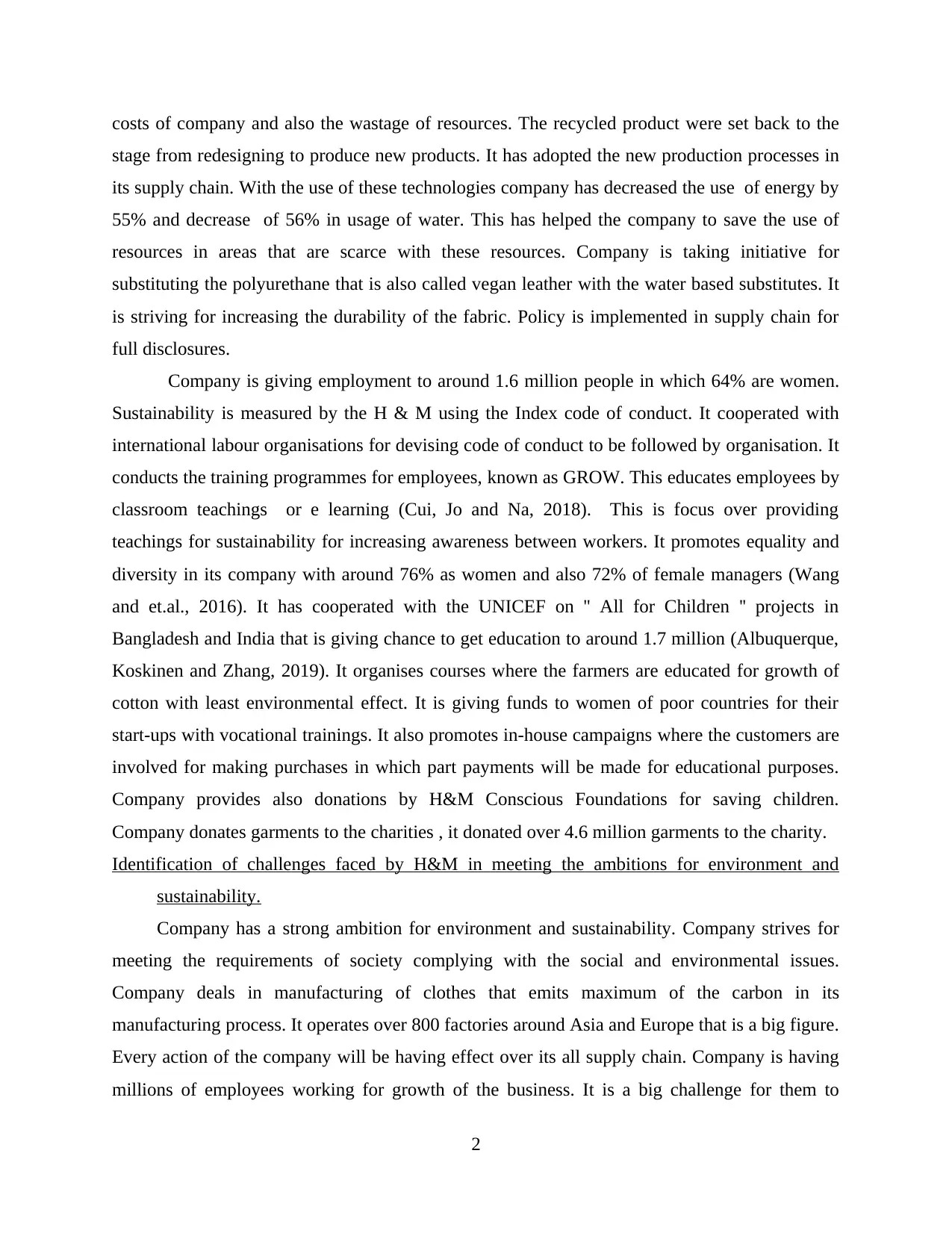
costs of company and also the wastage of resources. The recycled product were set back to the
stage from redesigning to produce new products. It has adopted the new production processes in
its supply chain. With the use of these technologies company has decreased the use of energy by
55% and decrease of 56% in usage of water. This has helped the company to save the use of
resources in areas that are scarce with these resources. Company is taking initiative for
substituting the polyurethane that is also called vegan leather with the water based substitutes. It
is striving for increasing the durability of the fabric. Policy is implemented in supply chain for
full disclosures.
Company is giving employment to around 1.6 million people in which 64% are women.
Sustainability is measured by the H & M using the Index code of conduct. It cooperated with
international labour organisations for devising code of conduct to be followed by organisation. It
conducts the training programmes for employees, known as GROW. This educates employees by
classroom teachings or e learning (Cui, Jo and Na, 2018). This is focus over providing
teachings for sustainability for increasing awareness between workers. It promotes equality and
diversity in its company with around 76% as women and also 72% of female managers (Wang
and et.al., 2016). It has cooperated with the UNICEF on '' All for Children '' projects in
Bangladesh and India that is giving chance to get education to around 1.7 million (Albuquerque,
Koskinen and Zhang, 2019). It organises courses where the farmers are educated for growth of
cotton with least environmental effect. It is giving funds to women of poor countries for their
start-ups with vocational trainings. It also promotes in-house campaigns where the customers are
involved for making purchases in which part payments will be made for educational purposes.
Company provides also donations by H&M Conscious Foundations for saving children.
Company donates garments to the charities , it donated over 4.6 million garments to the charity.
Identification of challenges faced by H&M in meeting the ambitions for environment and
sustainability.
Company has a strong ambition for environment and sustainability. Company strives for
meeting the requirements of society complying with the social and environmental issues.
Company deals in manufacturing of clothes that emits maximum of the carbon in its
manufacturing process. It operates over 800 factories around Asia and Europe that is a big figure.
Every action of the company will be having effect over its all supply chain. Company is having
millions of employees working for growth of the business. It is a big challenge for them to
2
stage from redesigning to produce new products. It has adopted the new production processes in
its supply chain. With the use of these technologies company has decreased the use of energy by
55% and decrease of 56% in usage of water. This has helped the company to save the use of
resources in areas that are scarce with these resources. Company is taking initiative for
substituting the polyurethane that is also called vegan leather with the water based substitutes. It
is striving for increasing the durability of the fabric. Policy is implemented in supply chain for
full disclosures.
Company is giving employment to around 1.6 million people in which 64% are women.
Sustainability is measured by the H & M using the Index code of conduct. It cooperated with
international labour organisations for devising code of conduct to be followed by organisation. It
conducts the training programmes for employees, known as GROW. This educates employees by
classroom teachings or e learning (Cui, Jo and Na, 2018). This is focus over providing
teachings for sustainability for increasing awareness between workers. It promotes equality and
diversity in its company with around 76% as women and also 72% of female managers (Wang
and et.al., 2016). It has cooperated with the UNICEF on '' All for Children '' projects in
Bangladesh and India that is giving chance to get education to around 1.7 million (Albuquerque,
Koskinen and Zhang, 2019). It organises courses where the farmers are educated for growth of
cotton with least environmental effect. It is giving funds to women of poor countries for their
start-ups with vocational trainings. It also promotes in-house campaigns where the customers are
involved for making purchases in which part payments will be made for educational purposes.
Company provides also donations by H&M Conscious Foundations for saving children.
Company donates garments to the charities , it donated over 4.6 million garments to the charity.
Identification of challenges faced by H&M in meeting the ambitions for environment and
sustainability.
Company has a strong ambition for environment and sustainability. Company strives for
meeting the requirements of society complying with the social and environmental issues.
Company deals in manufacturing of clothes that emits maximum of the carbon in its
manufacturing process. It operates over 800 factories around Asia and Europe that is a big figure.
Every action of the company will be having effect over its all supply chain. Company is having
millions of employees working for growth of the business. It is a big challenge for them to
2
Paraphrase This Document
Need a fresh take? Get an instant paraphrase of this document with our AI Paraphraser
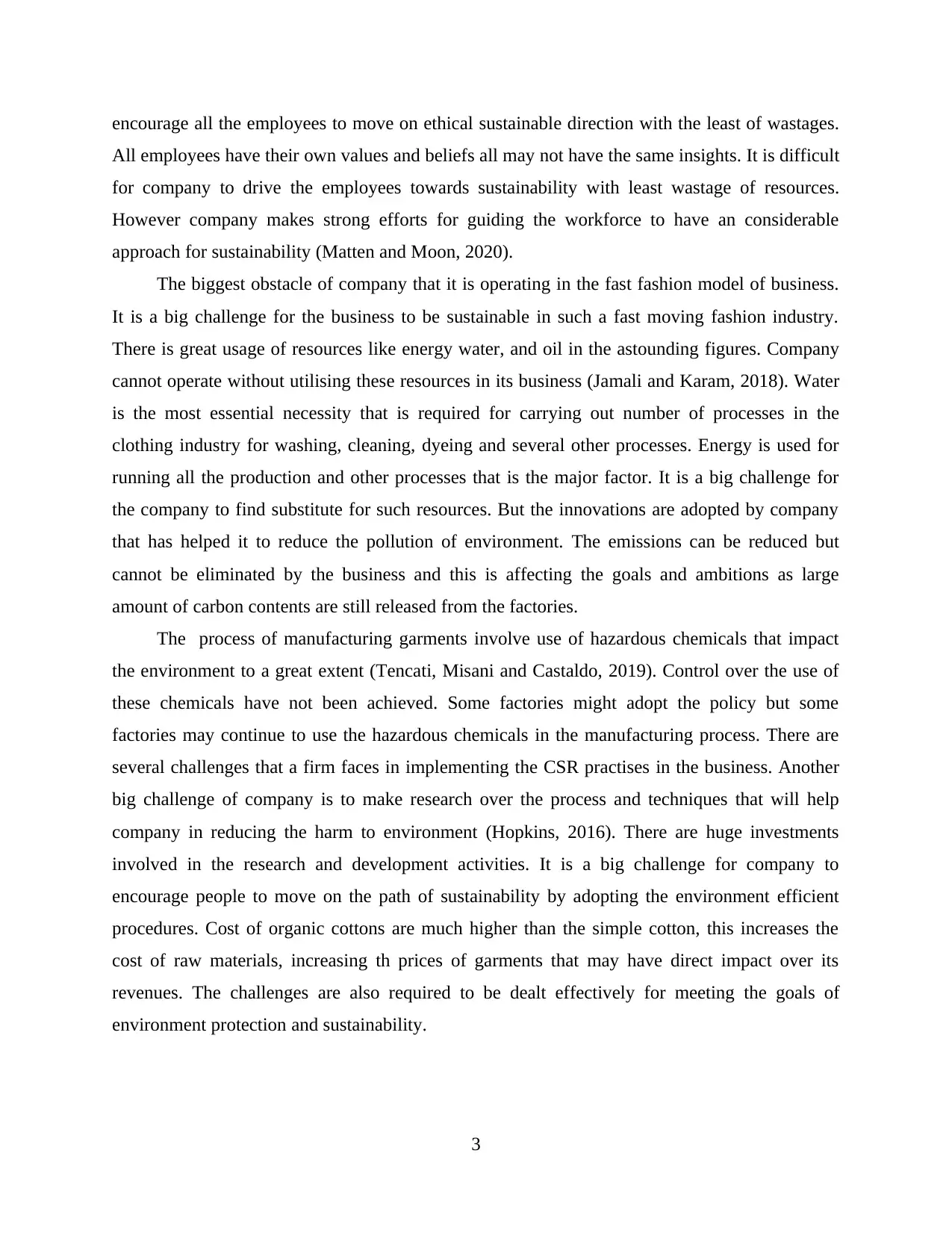
encourage all the employees to move on ethical sustainable direction with the least of wastages.
All employees have their own values and beliefs all may not have the same insights. It is difficult
for company to drive the employees towards sustainability with least wastage of resources.
However company makes strong efforts for guiding the workforce to have an considerable
approach for sustainability (Matten and Moon, 2020).
The biggest obstacle of company that it is operating in the fast fashion model of business.
It is a big challenge for the business to be sustainable in such a fast moving fashion industry.
There is great usage of resources like energy water, and oil in the astounding figures. Company
cannot operate without utilising these resources in its business (Jamali and Karam, 2018). Water
is the most essential necessity that is required for carrying out number of processes in the
clothing industry for washing, cleaning, dyeing and several other processes. Energy is used for
running all the production and other processes that is the major factor. It is a big challenge for
the company to find substitute for such resources. But the innovations are adopted by company
that has helped it to reduce the pollution of environment. The emissions can be reduced but
cannot be eliminated by the business and this is affecting the goals and ambitions as large
amount of carbon contents are still released from the factories.
The process of manufacturing garments involve use of hazardous chemicals that impact
the environment to a great extent (Tencati, Misani and Castaldo, 2019). Control over the use of
these chemicals have not been achieved. Some factories might adopt the policy but some
factories may continue to use the hazardous chemicals in the manufacturing process. There are
several challenges that a firm faces in implementing the CSR practises in the business. Another
big challenge of company is to make research over the process and techniques that will help
company in reducing the harm to environment (Hopkins, 2016). There are huge investments
involved in the research and development activities. It is a big challenge for company to
encourage people to move on the path of sustainability by adopting the environment efficient
procedures. Cost of organic cottons are much higher than the simple cotton, this increases the
cost of raw materials, increasing th prices of garments that may have direct impact over its
revenues. The challenges are also required to be dealt effectively for meeting the goals of
environment protection and sustainability.
3
All employees have their own values and beliefs all may not have the same insights. It is difficult
for company to drive the employees towards sustainability with least wastage of resources.
However company makes strong efforts for guiding the workforce to have an considerable
approach for sustainability (Matten and Moon, 2020).
The biggest obstacle of company that it is operating in the fast fashion model of business.
It is a big challenge for the business to be sustainable in such a fast moving fashion industry.
There is great usage of resources like energy water, and oil in the astounding figures. Company
cannot operate without utilising these resources in its business (Jamali and Karam, 2018). Water
is the most essential necessity that is required for carrying out number of processes in the
clothing industry for washing, cleaning, dyeing and several other processes. Energy is used for
running all the production and other processes that is the major factor. It is a big challenge for
the company to find substitute for such resources. But the innovations are adopted by company
that has helped it to reduce the pollution of environment. The emissions can be reduced but
cannot be eliminated by the business and this is affecting the goals and ambitions as large
amount of carbon contents are still released from the factories.
The process of manufacturing garments involve use of hazardous chemicals that impact
the environment to a great extent (Tencati, Misani and Castaldo, 2019). Control over the use of
these chemicals have not been achieved. Some factories might adopt the policy but some
factories may continue to use the hazardous chemicals in the manufacturing process. There are
several challenges that a firm faces in implementing the CSR practises in the business. Another
big challenge of company is to make research over the process and techniques that will help
company in reducing the harm to environment (Hopkins, 2016). There are huge investments
involved in the research and development activities. It is a big challenge for company to
encourage people to move on the path of sustainability by adopting the environment efficient
procedures. Cost of organic cottons are much higher than the simple cotton, this increases the
cost of raw materials, increasing th prices of garments that may have direct impact over its
revenues. The challenges are also required to be dealt effectively for meeting the goals of
environment protection and sustainability.
3
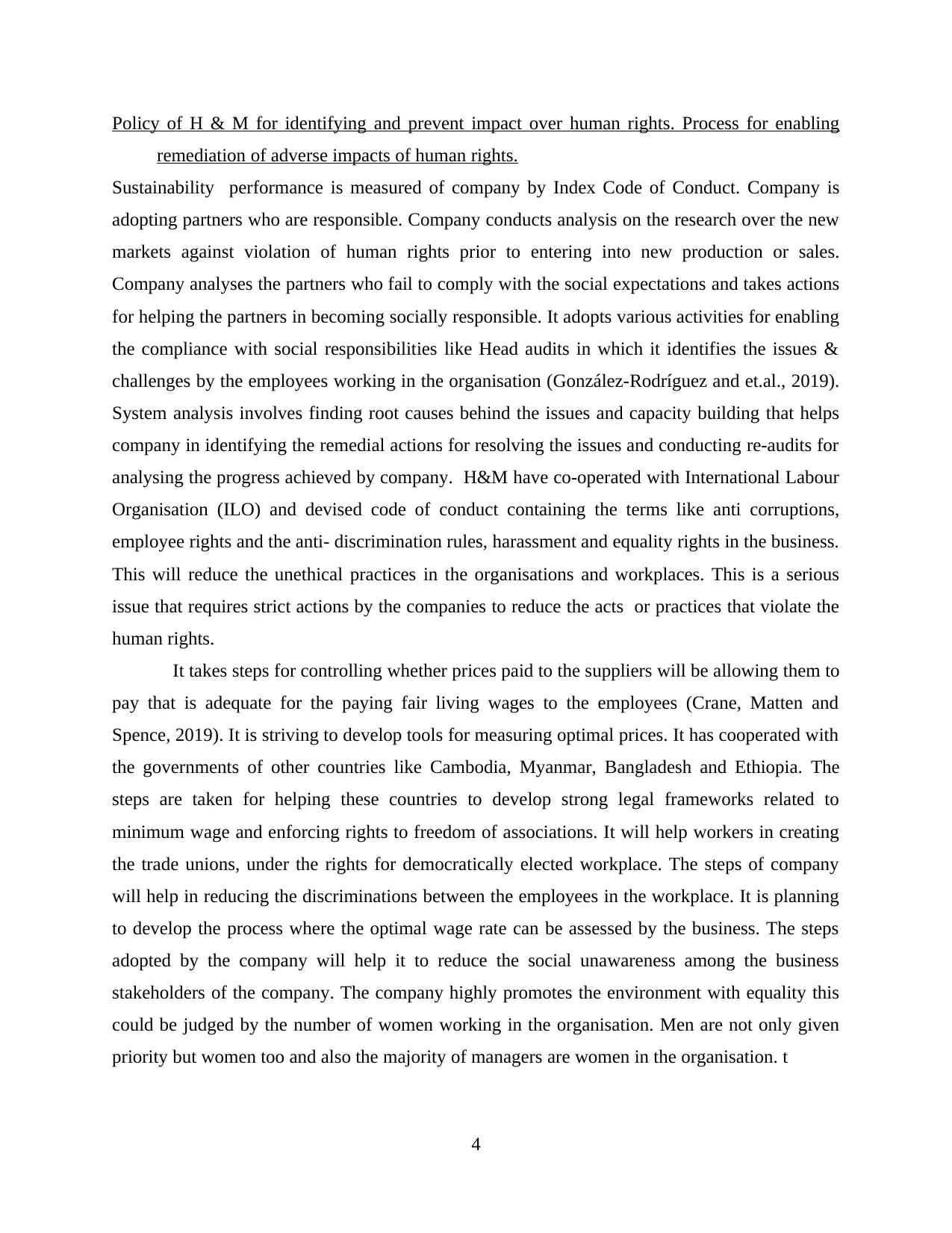
Policy of H & M for identifying and prevent impact over human rights. Process for enabling
remediation of adverse impacts of human rights.
Sustainability performance is measured of company by Index Code of Conduct. Company is
adopting partners who are responsible. Company conducts analysis on the research over the new
markets against violation of human rights prior to entering into new production or sales.
Company analyses the partners who fail to comply with the social expectations and takes actions
for helping the partners in becoming socially responsible. It adopts various activities for enabling
the compliance with social responsibilities like Head audits in which it identifies the issues &
challenges by the employees working in the organisation (González-Rodríguez and et.al., 2019).
System analysis involves finding root causes behind the issues and capacity building that helps
company in identifying the remedial actions for resolving the issues and conducting re-audits for
analysing the progress achieved by company. H&M have co-operated with International Labour
Organisation (ILO) and devised code of conduct containing the terms like anti corruptions,
employee rights and the anti- discrimination rules, harassment and equality rights in the business.
This will reduce the unethical practices in the organisations and workplaces. This is a serious
issue that requires strict actions by the companies to reduce the acts or practices that violate the
human rights.
It takes steps for controlling whether prices paid to the suppliers will be allowing them to
pay that is adequate for the paying fair living wages to the employees (Crane, Matten and
Spence, 2019). It is striving to develop tools for measuring optimal prices. It has cooperated with
the governments of other countries like Cambodia, Myanmar, Bangladesh and Ethiopia. The
steps are taken for helping these countries to develop strong legal frameworks related to
minimum wage and enforcing rights to freedom of associations. It will help workers in creating
the trade unions, under the rights for democratically elected workplace. The steps of company
will help in reducing the discriminations between the employees in the workplace. It is planning
to develop the process where the optimal wage rate can be assessed by the business. The steps
adopted by the company will help it to reduce the social unawareness among the business
stakeholders of the company. The company highly promotes the environment with equality this
could be judged by the number of women working in the organisation. Men are not only given
priority but women too and also the majority of managers are women in the organisation. t
4
remediation of adverse impacts of human rights.
Sustainability performance is measured of company by Index Code of Conduct. Company is
adopting partners who are responsible. Company conducts analysis on the research over the new
markets against violation of human rights prior to entering into new production or sales.
Company analyses the partners who fail to comply with the social expectations and takes actions
for helping the partners in becoming socially responsible. It adopts various activities for enabling
the compliance with social responsibilities like Head audits in which it identifies the issues &
challenges by the employees working in the organisation (González-Rodríguez and et.al., 2019).
System analysis involves finding root causes behind the issues and capacity building that helps
company in identifying the remedial actions for resolving the issues and conducting re-audits for
analysing the progress achieved by company. H&M have co-operated with International Labour
Organisation (ILO) and devised code of conduct containing the terms like anti corruptions,
employee rights and the anti- discrimination rules, harassment and equality rights in the business.
This will reduce the unethical practices in the organisations and workplaces. This is a serious
issue that requires strict actions by the companies to reduce the acts or practices that violate the
human rights.
It takes steps for controlling whether prices paid to the suppliers will be allowing them to
pay that is adequate for the paying fair living wages to the employees (Crane, Matten and
Spence, 2019). It is striving to develop tools for measuring optimal prices. It has cooperated with
the governments of other countries like Cambodia, Myanmar, Bangladesh and Ethiopia. The
steps are taken for helping these countries to develop strong legal frameworks related to
minimum wage and enforcing rights to freedom of associations. It will help workers in creating
the trade unions, under the rights for democratically elected workplace. The steps of company
will help in reducing the discriminations between the employees in the workplace. It is planning
to develop the process where the optimal wage rate can be assessed by the business. The steps
adopted by the company will help it to reduce the social unawareness among the business
stakeholders of the company. The company highly promotes the environment with equality this
could be judged by the number of women working in the organisation. Men are not only given
priority but women too and also the majority of managers are women in the organisation. t
4
⊘ This is a preview!⊘
Do you want full access?
Subscribe today to unlock all pages.

Trusted by 1+ million students worldwide
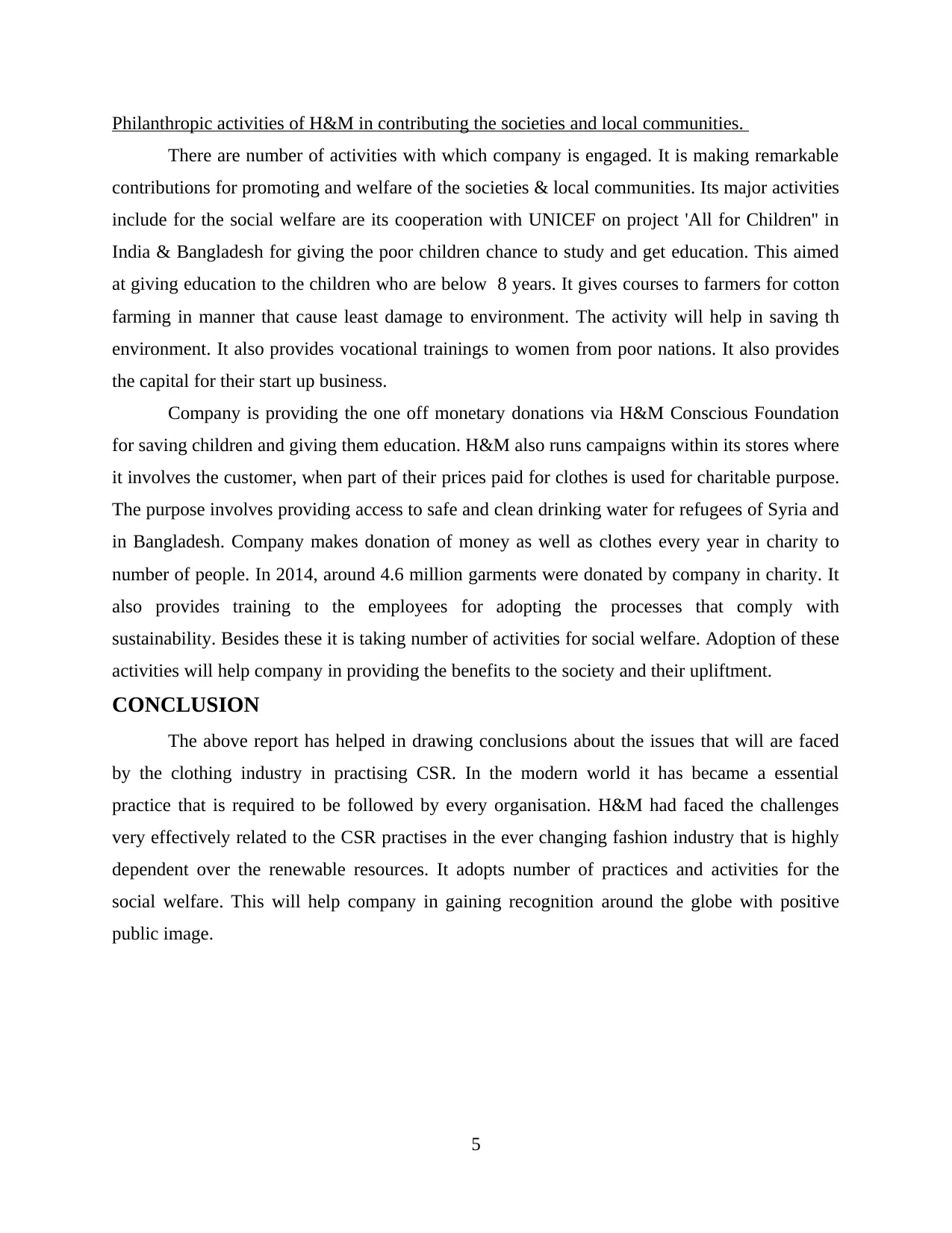
Philanthropic activities of H&M in contributing the societies and local communities.
There are number of activities with which company is engaged. It is making remarkable
contributions for promoting and welfare of the societies & local communities. Its major activities
include for the social welfare are its cooperation with UNICEF on project 'All for Children'' in
India & Bangladesh for giving the poor children chance to study and get education. This aimed
at giving education to the children who are below 8 years. It gives courses to farmers for cotton
farming in manner that cause least damage to environment. The activity will help in saving th
environment. It also provides vocational trainings to women from poor nations. It also provides
the capital for their start up business.
Company is providing the one off monetary donations via H&M Conscious Foundation
for saving children and giving them education. H&M also runs campaigns within its stores where
it involves the customer, when part of their prices paid for clothes is used for charitable purpose.
The purpose involves providing access to safe and clean drinking water for refugees of Syria and
in Bangladesh. Company makes donation of money as well as clothes every year in charity to
number of people. In 2014, around 4.6 million garments were donated by company in charity. It
also provides training to the employees for adopting the processes that comply with
sustainability. Besides these it is taking number of activities for social welfare. Adoption of these
activities will help company in providing the benefits to the society and their upliftment.
CONCLUSION
The above report has helped in drawing conclusions about the issues that will are faced
by the clothing industry in practising CSR. In the modern world it has became a essential
practice that is required to be followed by every organisation. H&M had faced the challenges
very effectively related to the CSR practises in the ever changing fashion industry that is highly
dependent over the renewable resources. It adopts number of practices and activities for the
social welfare. This will help company in gaining recognition around the globe with positive
public image.
5
There are number of activities with which company is engaged. It is making remarkable
contributions for promoting and welfare of the societies & local communities. Its major activities
include for the social welfare are its cooperation with UNICEF on project 'All for Children'' in
India & Bangladesh for giving the poor children chance to study and get education. This aimed
at giving education to the children who are below 8 years. It gives courses to farmers for cotton
farming in manner that cause least damage to environment. The activity will help in saving th
environment. It also provides vocational trainings to women from poor nations. It also provides
the capital for their start up business.
Company is providing the one off monetary donations via H&M Conscious Foundation
for saving children and giving them education. H&M also runs campaigns within its stores where
it involves the customer, when part of their prices paid for clothes is used for charitable purpose.
The purpose involves providing access to safe and clean drinking water for refugees of Syria and
in Bangladesh. Company makes donation of money as well as clothes every year in charity to
number of people. In 2014, around 4.6 million garments were donated by company in charity. It
also provides training to the employees for adopting the processes that comply with
sustainability. Besides these it is taking number of activities for social welfare. Adoption of these
activities will help company in providing the benefits to the society and their upliftment.
CONCLUSION
The above report has helped in drawing conclusions about the issues that will are faced
by the clothing industry in practising CSR. In the modern world it has became a essential
practice that is required to be followed by every organisation. H&M had faced the challenges
very effectively related to the CSR practises in the ever changing fashion industry that is highly
dependent over the renewable resources. It adopts number of practices and activities for the
social welfare. This will help company in gaining recognition around the globe with positive
public image.
5
Paraphrase This Document
Need a fresh take? Get an instant paraphrase of this document with our AI Paraphraser
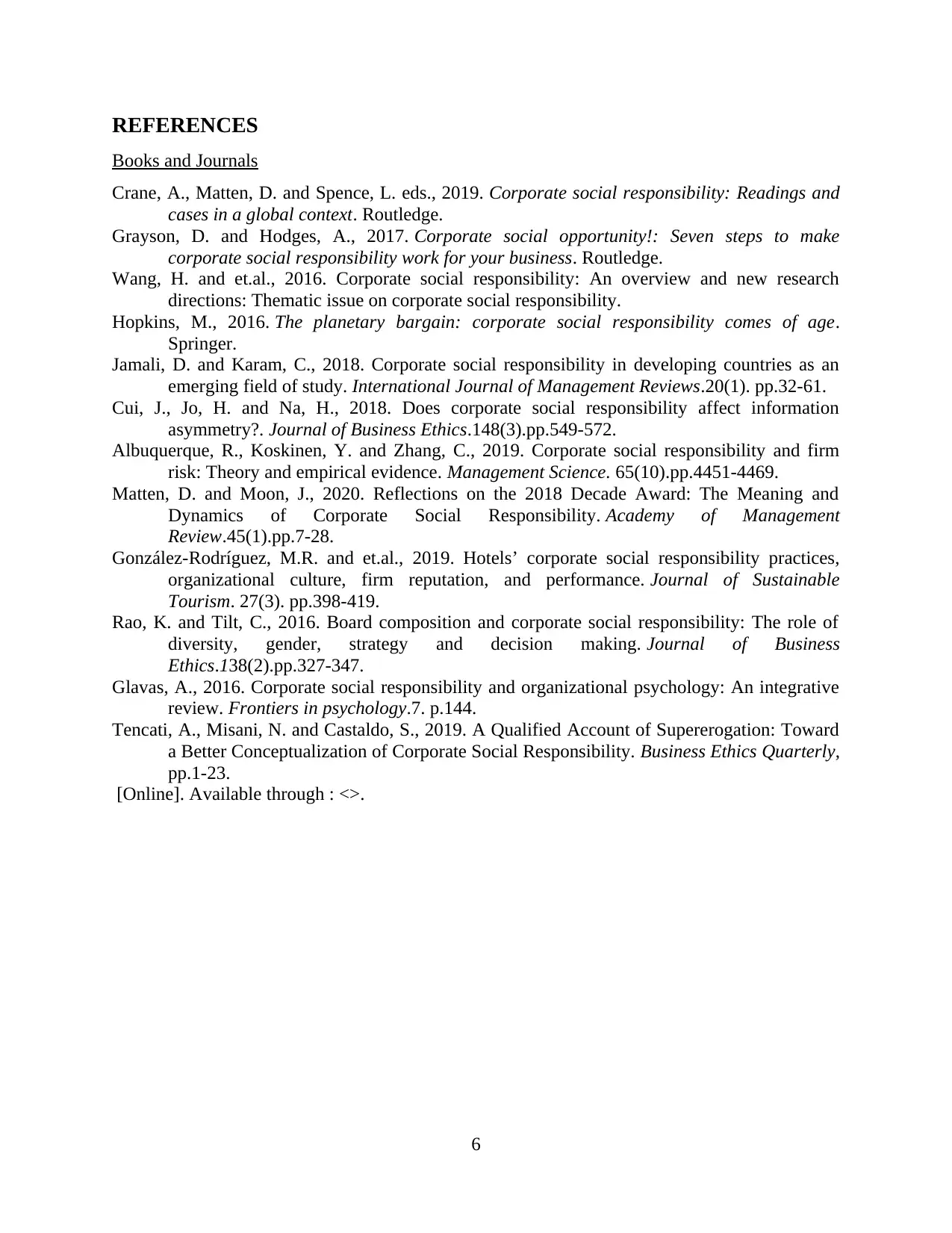
REFERENCES
Books and Journals
Crane, A., Matten, D. and Spence, L. eds., 2019. Corporate social responsibility: Readings and
cases in a global context. Routledge.
Grayson, D. and Hodges, A., 2017. Corporate social opportunity!: Seven steps to make
corporate social responsibility work for your business. Routledge.
Wang, H. and et.al., 2016. Corporate social responsibility: An overview and new research
directions: Thematic issue on corporate social responsibility.
Hopkins, M., 2016. The planetary bargain: corporate social responsibility comes of age.
Springer.
Jamali, D. and Karam, C., 2018. Corporate social responsibility in developing countries as an
emerging field of study. International Journal of Management Reviews.20(1). pp.32-61.
Cui, J., Jo, H. and Na, H., 2018. Does corporate social responsibility affect information
asymmetry?. Journal of Business Ethics.148(3).pp.549-572.
Albuquerque, R., Koskinen, Y. and Zhang, C., 2019. Corporate social responsibility and firm
risk: Theory and empirical evidence. Management Science. 65(10).pp.4451-4469.
Matten, D. and Moon, J., 2020. Reflections on the 2018 Decade Award: The Meaning and
Dynamics of Corporate Social Responsibility. Academy of Management
Review.45(1).pp.7-28.
González-Rodríguez, M.R. and et.al., 2019. Hotels’ corporate social responsibility practices,
organizational culture, firm reputation, and performance. Journal of Sustainable
Tourism. 27(3). pp.398-419.
Rao, K. and Tilt, C., 2016. Board composition and corporate social responsibility: The role of
diversity, gender, strategy and decision making. Journal of Business
Ethics.138(2).pp.327-347.
Glavas, A., 2016. Corporate social responsibility and organizational psychology: An integrative
review. Frontiers in psychology.7. p.144.
Tencati, A., Misani, N. and Castaldo, S., 2019. A Qualified Account of Supererogation: Toward
a Better Conceptualization of Corporate Social Responsibility. Business Ethics Quarterly,
pp.1-23.
[Online]. Available through : <>.
6
Books and Journals
Crane, A., Matten, D. and Spence, L. eds., 2019. Corporate social responsibility: Readings and
cases in a global context. Routledge.
Grayson, D. and Hodges, A., 2017. Corporate social opportunity!: Seven steps to make
corporate social responsibility work for your business. Routledge.
Wang, H. and et.al., 2016. Corporate social responsibility: An overview and new research
directions: Thematic issue on corporate social responsibility.
Hopkins, M., 2016. The planetary bargain: corporate social responsibility comes of age.
Springer.
Jamali, D. and Karam, C., 2018. Corporate social responsibility in developing countries as an
emerging field of study. International Journal of Management Reviews.20(1). pp.32-61.
Cui, J., Jo, H. and Na, H., 2018. Does corporate social responsibility affect information
asymmetry?. Journal of Business Ethics.148(3).pp.549-572.
Albuquerque, R., Koskinen, Y. and Zhang, C., 2019. Corporate social responsibility and firm
risk: Theory and empirical evidence. Management Science. 65(10).pp.4451-4469.
Matten, D. and Moon, J., 2020. Reflections on the 2018 Decade Award: The Meaning and
Dynamics of Corporate Social Responsibility. Academy of Management
Review.45(1).pp.7-28.
González-Rodríguez, M.R. and et.al., 2019. Hotels’ corporate social responsibility practices,
organizational culture, firm reputation, and performance. Journal of Sustainable
Tourism. 27(3). pp.398-419.
Rao, K. and Tilt, C., 2016. Board composition and corporate social responsibility: The role of
diversity, gender, strategy and decision making. Journal of Business
Ethics.138(2).pp.327-347.
Glavas, A., 2016. Corporate social responsibility and organizational psychology: An integrative
review. Frontiers in psychology.7. p.144.
Tencati, A., Misani, N. and Castaldo, S., 2019. A Qualified Account of Supererogation: Toward
a Better Conceptualization of Corporate Social Responsibility. Business Ethics Quarterly,
pp.1-23.
[Online]. Available through : <>.
6
1 out of 8
Related Documents
Your All-in-One AI-Powered Toolkit for Academic Success.
+13062052269
info@desklib.com
Available 24*7 on WhatsApp / Email
![[object Object]](/_next/static/media/star-bottom.7253800d.svg)
Unlock your academic potential
Copyright © 2020–2025 A2Z Services. All Rights Reserved. Developed and managed by ZUCOL.





